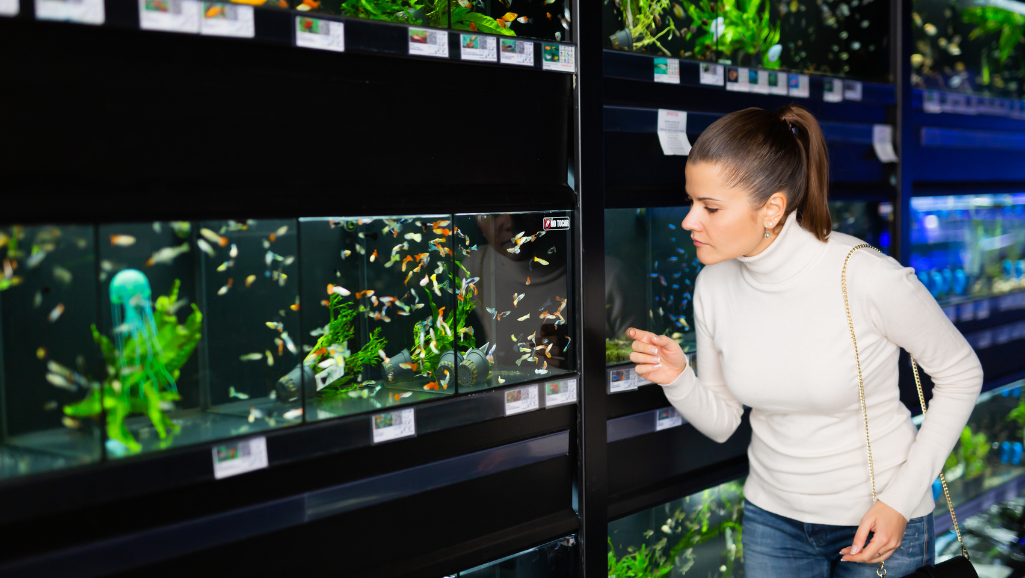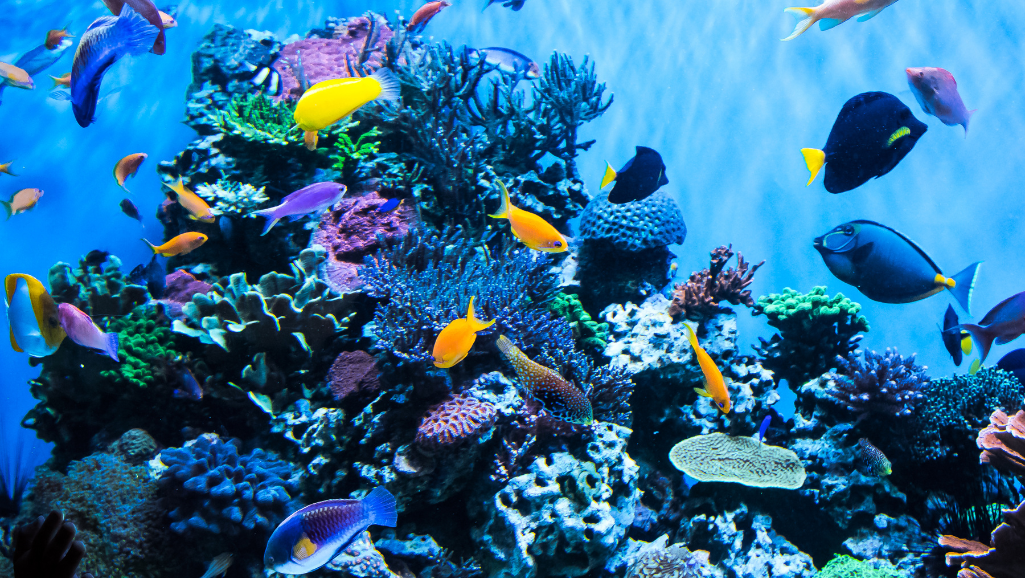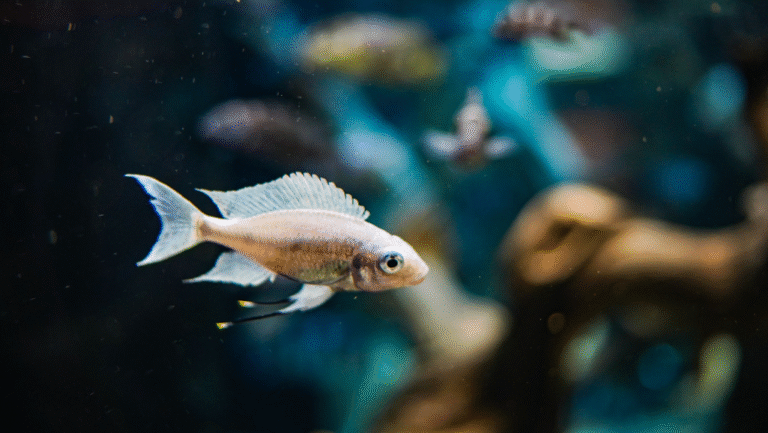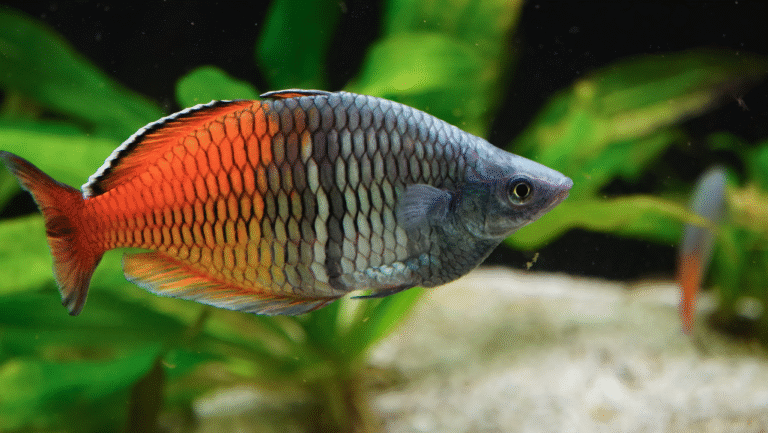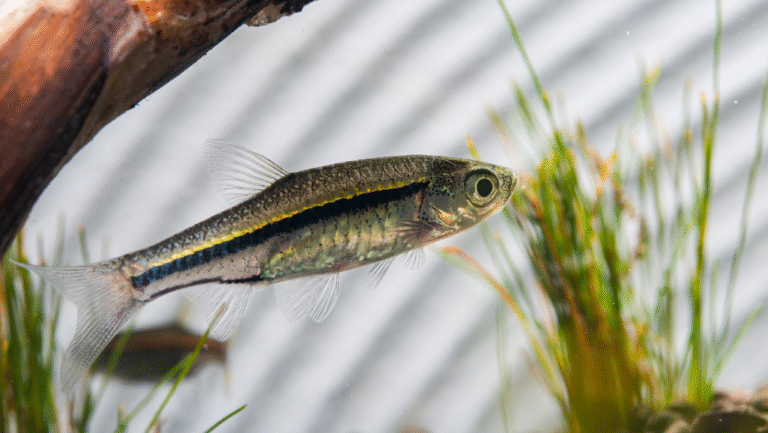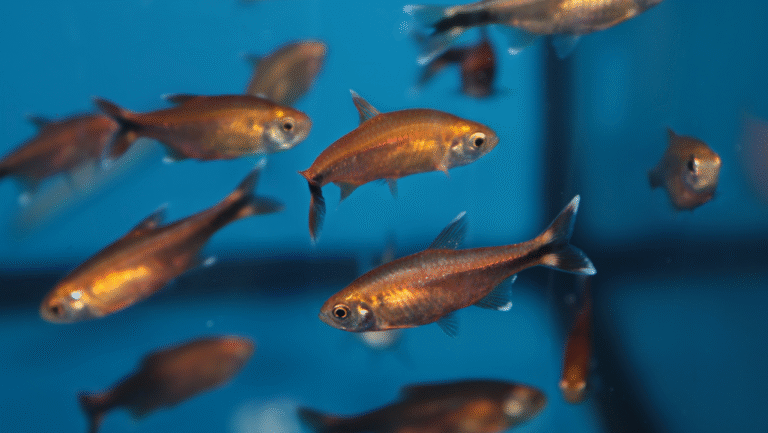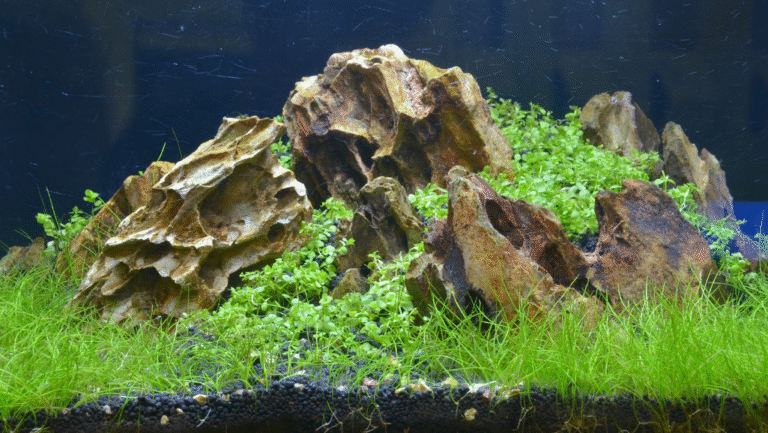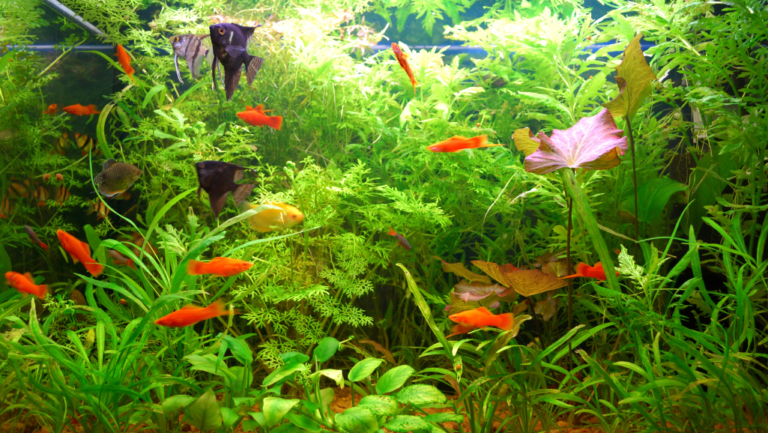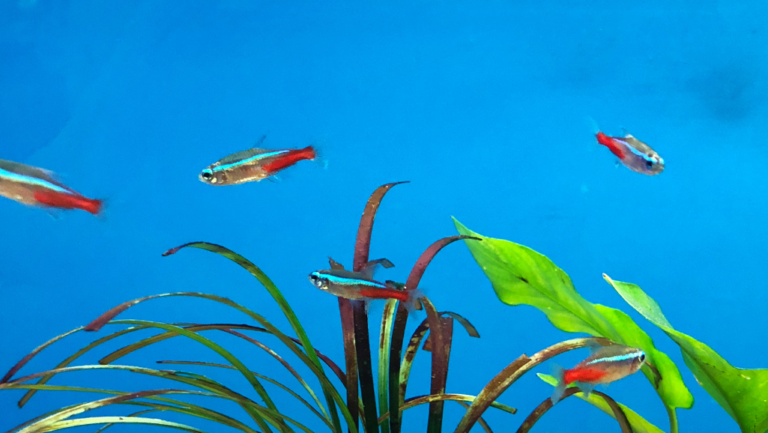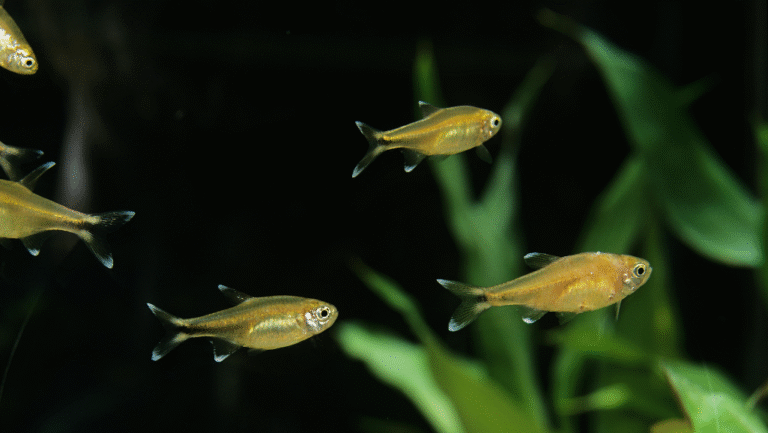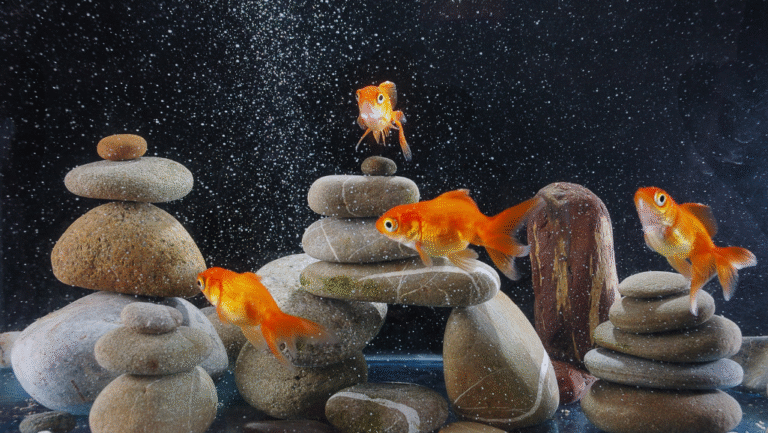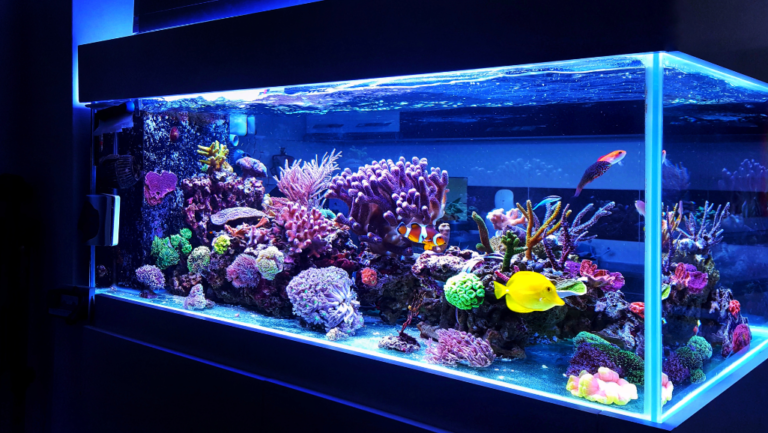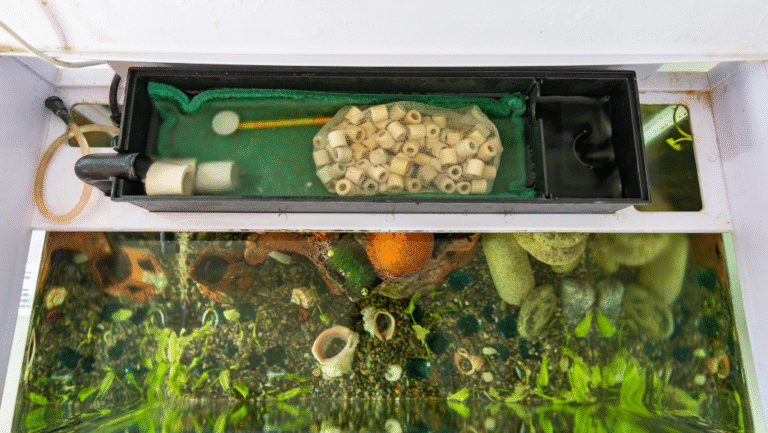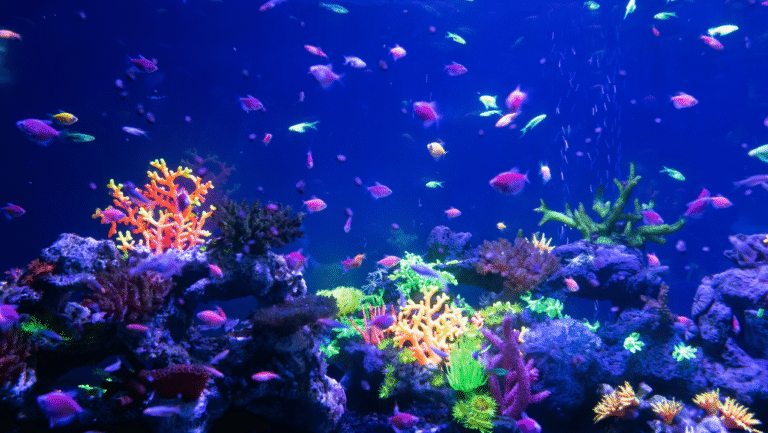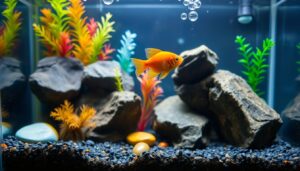Welcome to our guide on setting up and keeping an aquarium fish tank. This guide is for both beginners and experienced aquarists. We’ll cover choosing the right tank size, essential equipment, and picking the right fish species.
Keeping an aquarium with tropical fish is a rewarding hobby. It lets you create a beautiful underwater world at home. With the right care, your tank can be filled with vibrant, healthy fish. We’ll share the info and tips you need for a successful aquarium journey.
Key Takeaways
- Complete Guide to Aquarium Fish Tank With Fish
- Learn about the importance of fish tanks in aquatic life and the benefits of keeping an aquarium
- Understand how to choose the right aquarium size based on factors like fish species and available space
- Discover the essential equipment needed for a healthy aquarium, including filters, heaters, and lighting
- Gain insights into preparing your aquarium environment, selecting compatible fish species, and proper feeding practices
- Acquire knowledge on maintaining water quality, addressing common health issues, and aquascaping your fish tank
So, let’s dive in and explore the fascinating world of aquarium fish tanks with fish!
Introduction to Aquarium Fish Tanks
Aquarium fish tanks are loved by many. They bring elegance and a peek into aquatic life to any room.
Importance of Fish Tanks in Aquatic Life
Fish tanks are key for showing off aquatic creatures. They mimic natural habitats, letting fish and plants live safely. They help in saving endangered species by breeding them in a controlled space.
Overview of Popular Fish Species
There are many fish species for aquariums. Some favorites include:
- Guppies
- Neon Tetras
- Angelfish
- Bettas
- Mollies
Each fish has its own traits and needs. It’s important to pick ones that get along.
Benefits of Keeping an Aquarium
Aquariums are more than pretty. They help people relax and can even teach about nature. Watching fish can calm you down.
As Martin R. Speight, a famous fish expert, said,
“An aquarium is not just a box of water; it is a window into another world, a world of beauty, tranquility, and endless fascination.”
For both new and experienced aquarists, aquariums are a great hobby. They let you enjoy underwater life at home.
Choosing the Right Aquarium Size
Choosing the right fish tank size is key when starting a new aquarium. The size affects your fish’s health and the upkeep of your tank. Let’s look at the common sizes and what to think about when picking the best one for your fish.
Standard Sizes of Fish Tanks
Aquariums come in various sizes to meet different needs. Here are some common sizes:
- 10 gallons (38 liters): Good for small fish or shrimp
- 20 gallons (76 liters): Great for beginners
- 29 gallons (110 liters): More space for a variety of fish
- 55 gallons (208 liters): Ideal for larger fish or detailed aquascaping
- 75 gallons (284 liters) and up: For those with lots of space and experience
Bigger tanks offer better water stability and can hold more fish. But, they need more room, gear, and care.
Factors to Consider for Size Selection
Think about these when picking your tank size:
- Number and type of fish: Know the adult size and social needs of your fish. Make sure the tank is big enough for them.
- Available space: Measure where you’ll put the tank. Pick a size that fits without taking over the room.
- Maintenance requirements: Bigger tanks need less frequent water changes but more powerful filters and heaters.
“Give a man a fish, and you feed him for a day. Teach a man to fish, and you feed him for a lifetime.” – Chinese Proverb
By carefully thinking about these points and choosing the right size, you’ll have a happy and peaceful underwater world at home.
Essential Equipment for Your Fish Tank
To keep your fish healthy, you need more than just a tank and water. You must get aquarium equipment that keeps the water right and makes a comfy home for your fish.
Filters: Types and Importance
Fish tank filters are key for clean water. They get rid of waste, debris, and bad stuff. There are three main types:
- Mechanical filters catch solid waste
- Biological filters use good bacteria to clean ammonia and nitrites
- Chemical filters, like activated carbon, take out pollutants and smells
Picking the right filter is vital for a healthy tank.
Heaters: Maintaining the Right Temperature
Tropical fish need water between 75°F and 80°F (24°C – 27°C). Aquarium heaters keep this temperature, helping your fish stay healthy. Choose a heater that fits your tank size and fish needs.
“Keeping the water temperature steady is important. Get a good heater and check it often to keep your fish happy and healthy.”
Lighting: Options for Aquatic Plants and Fish
Good lighting makes your tank look great and helps plants and fish. LED lights are popular for being energy-saving and having many color options. Think about what your plants and fish need, and what look you want for your tank.
With top-notch filters, heaters, and lights, you’ll have a beautiful and healthy home for your fish. They’ll love it for a long time.
Preparing Your Aquarium for Fish
Before you can add fish to your new aquarium, you need to set it up right. This means following a few important steps. These steps help create a healthy home for your fish. Let’s look at the basics of setting up your tank, including choosing the right substrate, decorations, and starting the nitrogen cycle.
Setting Up Your Tank Environment
Starting a successful aquarium begins with a good setup. First, clean your tank with mild soap and water. Then, rinse it well to get rid of any soap left behind. Place your tank in a spot that’s not too sunny and not too drafty. Make sure it’s on a stable, level surface that can hold a full tank.
Choosing Substrate and Decorations
Choosing the right substrate is key for both looks and your fish’s health. You can pick from gravel, sand, or plant substrates. Think about where your fish come from when picking your substrate. Decorations like rocks, driftwood, and plants make your tank look better. They also give your fish places to hide and claim as their own.
A well-designed aquarium substrate and decoration layout can mimic the natural environment of your fish, promoting their comfort and reducing stress.
Cycling Your Aquarium: The Nitrogen Cycle
Before you can add fish, you need to start the nitrogen cycle. This cycle helps turn bad stuff into something safer. Here’s how to start the cycle:
- Fill your tank with clean water and run the filter for 24-48 hours.
- Add a little fish food to the tank to start the cycle.
- Check the water often for ammonia, nitrites, and nitrates with a test kit.
- When ammonia and nitrite levels are zero and nitrates are up, your tank is ready for fish.
Be patient during the cycling process. It can take weeks to get everything balanced. Don’t add fish too early. It can harm their health and even cause them to die.
Selecting Your Fish Species
Choosing fish for your aquarium is exciting. You have many options. Think about your tank size, species compatibility, and whether you prefer freshwater or saltwater.
Freshwater vs. Saltwater Fish
Freshwater fish are easier to care for and less expensive. They’re perfect for beginner fish keepers. They need less special equipment and can handle water changes better.
Saltwater fish, though, offer more colorful and exotic species. But, they need stable water and special care.
Popular Freshwater Fish for Beginners
For beginners, here are some great freshwater fish:
- Guppies: These small, colorful fish are easy to care for and can adapt to a wide range of water conditions.
- Neon Tetras: Known for their vibrant blue and red stripes, neon tetras are peaceful schooling fish that add a pop of color to your tank.
- Zebra Danios: Hardy and active, zebra danios are a great choice for beginner aquariums. They prefer to be kept in schools of at least six.
“The key to a successful aquarium is selecting fish that are compatible with each other and suited to your level of experience.”
Tips for Choosing Compatible Species
Choosing the right fish is key for a peaceful aquarium. Here are some tips:
- Research the temperament and social needs of each species you’re interested in.
- Avoid mixing aggressive fish with peaceful species.
- Make sure the fish you choose have similar water parameter requirements.
- Consider the adult size of each species to ensure your tank can accommodate them as they grow.
By carefully choosing your fish, you’ll create a thriving community. This will bring you joy for years.
Proper Feeding Practices for Aquarium Fish
Feeding your aquarium fish the right food is key for their health. A consistent feeding schedule and portion control are essential. This ensures your fish get the nutrients they need and keeps the water quality good.
Types of Fish Food Available
There are many fish food options, each with its own benefits:
- Flakes: A favorite for many fish, flakes float on the surface and are easy to measure.
- Pellets: Sinking or floating pellets are great for fish that live in the middle or at the bottom, providing a rich source of nutrition.
- Frozen or live food: Foods like brine shrimp, bloodworms, or daphnia offer variety and mimic their natural diet.
“A varied diet is essential for the health and vibrance of your aquarium fish. Experiment with different types of food to keep things interesting and nutritionally balanced.”
Feeding Schedules and Portions
Having a regular feeding schedule is vital for your fish’s health. Most fish prefer two to three small meals a day. Always control the amount of food to avoid overfeeding, which can cause obesity and water quality problems.
Feed your fish an amount they can eat in 2-3 minutes. Adjust the portion based on their size and the needs of their species. It’s safer to underfeed than overfeed, as leftover food can harm the water quality.
Maintaining Water Quality in Your Tank
Keeping your aquarium water clean is key for your fish’s health. Regular aquarium maintenance and checking water parameters are vital. They help keep your aquarium water quality at its best.
- pH levels: Most freshwater fish like a pH between 6.5 and 7.5. Use a good pH test kit to check it often.
- Ammonia and nitrite: These harmful compounds can quickly rise in your tank. They can hurt your fish. Keep both at 0 ppm with good filtration and water changes.
- Nitrate: While not as toxic as ammonia and nitrite, high nitrate levels can stress your fish. Regular water changes help keep nitrate below 40 ppm.
Water Change Frequency and Technique
Changing some of your aquarium water regularly is key for great water quality. Aim to change 10-20% of your tank’s water every week. This removes waste and adds important minerals.
“The key to a healthy aquarium is consistency. Establish a routine for testing water parameters and performing water changes, and stick to it.”
When you change water, use a gravel vacuum to clean the substrate. Use a clean bucket only for your aquarium. Always treat new water with a dechlorinator to remove harmful chemicals like chlorine and chloramine.
By watching water parameters closely and sticking to a water change schedule, you’ll make a stable and healthy home for your fish.
Common Health Issues in Aquarium Fish
As a responsible aquarium owner, knowing about common health issues in fish is key. Even with a healthy environment, your fish might get sick. Learning to spot illness signs and how to act can keep your fish healthy.
Identifying Symptoms of Illness
Spotting when your fish are sick is a big part of aquarium fish care. Look out for signs like:
- Lethargy and decreased activity levels
- Loss of appetite or refusal to eat
- Abnormal swimming patterns or difficulty maintaining balance
- Visible wounds, lesions, or discoloration on the skin or fins
- Swelling or protruding eyes
- Rapid breathing or gasping at the water surface
If you see these signs, act fast to fix the problem and stop fish diseases from spreading.
Preventative Measures and Treatments
Preventing health issues is the best way to keep your fish healthy. Keep water quality high, feed them well, and don’t overcrowd. Regular water changes, good filtration, and checking water parameters can help a lot.
An ounce of prevention is worth a pound of cure.
If your fish get sick, there are treatments like medicated foods and antibiotics. It’s important to know what’s wrong with your fish and pick the right treatment. Talking to an aquarium expert or vet can help you choose the best option.
Acting quickly is important when your fish get sick. By watching for signs, acting fast, and using the right treatments, you can help your fish stay healthy and happy.
Aquascaping Your Fish Tank
Aquascaping turns your fish tank into a stunning underwater world. It uses plants, hardscape materials, and design to mimic nature. This makes your tank a beautiful display for your fish.
Basics of Aquascaping Design
When planning your aquascape, think about these key points:
- Layout: Pick a main focus and design around it. Use the golden ratio or rule of thirds for balance.
- Depth: Use tall plants and hardscape in the back and short ones up front to create depth.
- Texture: Mix plants and materials with different textures for interest and contrast.
- Color: Choose plants and fish that match each other for a harmonious look.
Recommended Plants and Hardscape Materials
When picking plants, think about their growth, size, and care needs. Here are some good choices:
- Java Fern (Microsorum pteropus)
- Anubias (Anubias barteri)
- Amazon Sword (Echinodorus amazonicus)
- Cryptocoryne (Cryptocoryne wendtii)
For hardscape, rocks and driftwood add structure and beauty. Make sure they’re safe for aquariums and match your plants and fish. Some favorites include:
- Dragon Stone
- Seiryu Stone
- Malaysian Driftwood
- Manzanita Wood
The key to a successful aquascape is patience and experimentation. Don’t be afraid to try new combinations and layouts until you find the perfect balance for your aquarium.
Mastering aquascaping lets you create a breathtaking underwater world. Your aquarium will become a stunning centerpiece in your home. With the right design, your fish tank will showcase the beauty of plants, hardscape, and fish.
Conclusion: Enjoying Your Aquarium Experience
Starting your aquarium hobby is just the beginning. There’s always more to learn and discover. By expanding your knowledge and joining the fish keeping community, you’ll find many ways to improve your aquarium.
Building Your Knowledge Further
There are many resources to help you learn more about aquarium care. Check out aquarium forums for tips from experienced hobbyists. Read books and magazines for detailed info on fish, tank care, and more.
By learning and applying new ideas, you’ll become more confident and skilled. This will help you take better care of your aquarium.
Community and Resources for Fish Keepers
Get involved with the fish keeping community online and locally. Join forums and social media groups to share and learn. Attend local club meetings for workshops and to meet others.
Being part of the aquarium community adds to your knowledge and brings friendship. It makes your aquarium journey more enjoyable.
As you care for your aquarium, take pride in your underwater world. The aquarium hobby is rewarding, bringing joy and peace. Enjoy watching your fish and feel happy knowing you’ve given them a great home.

